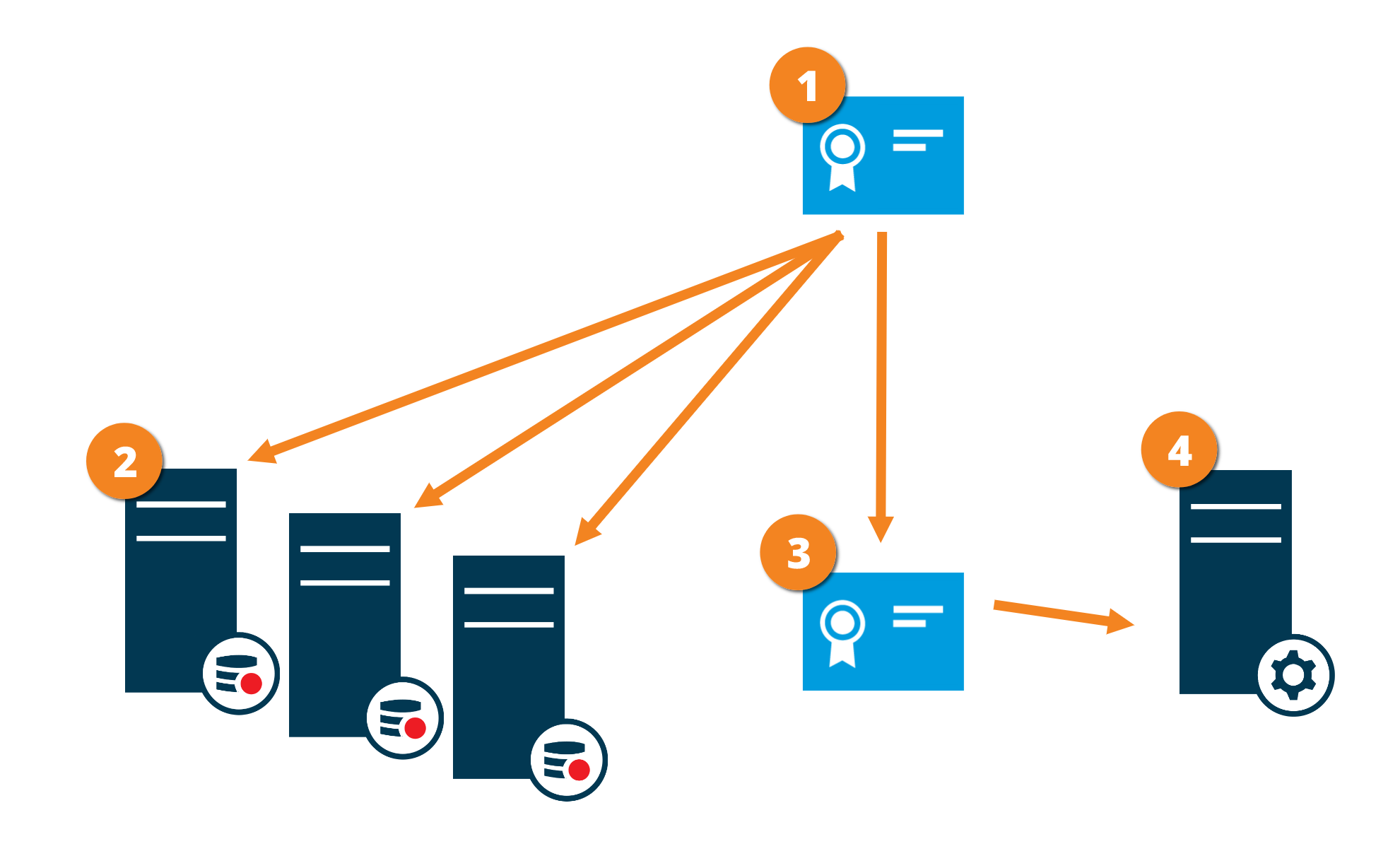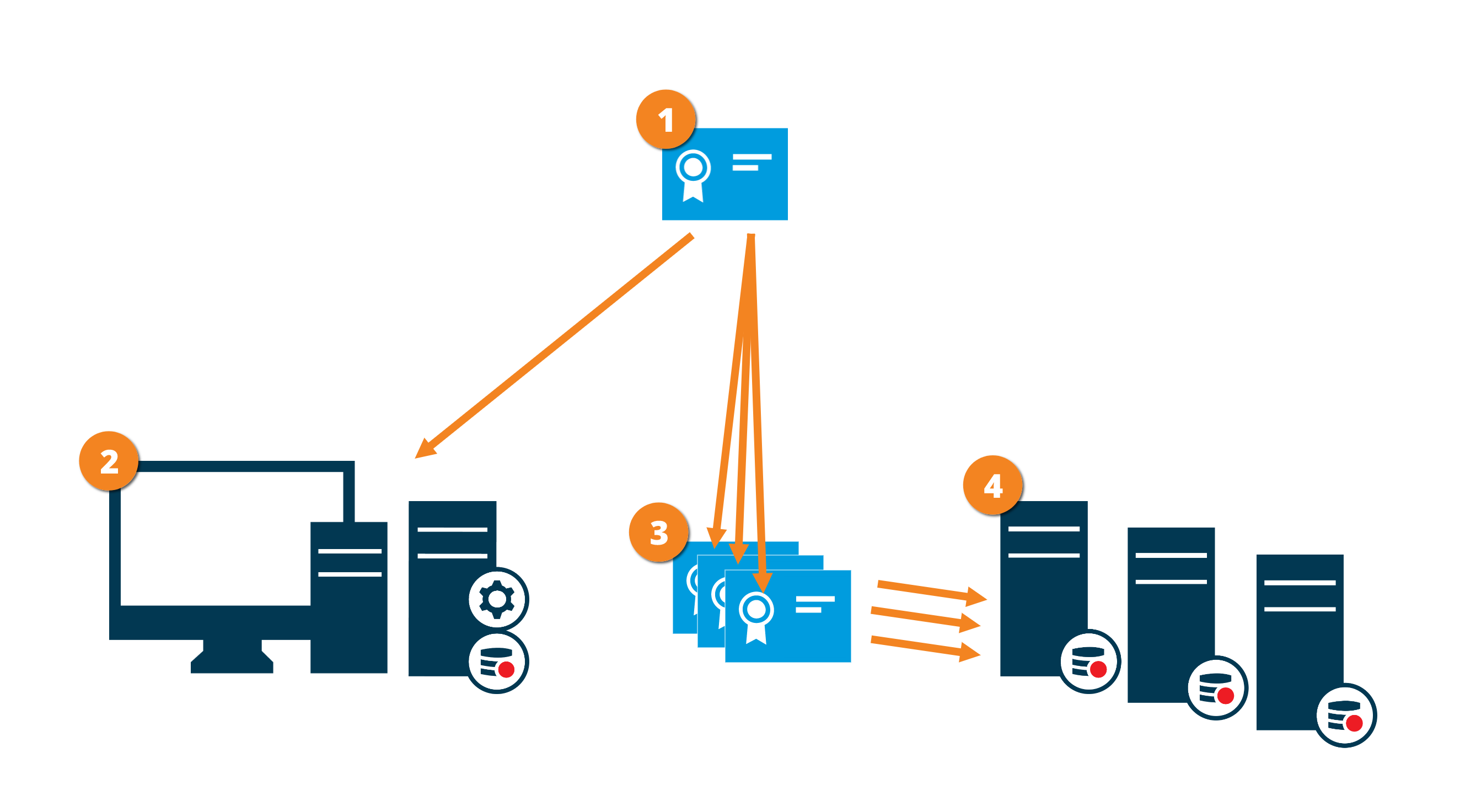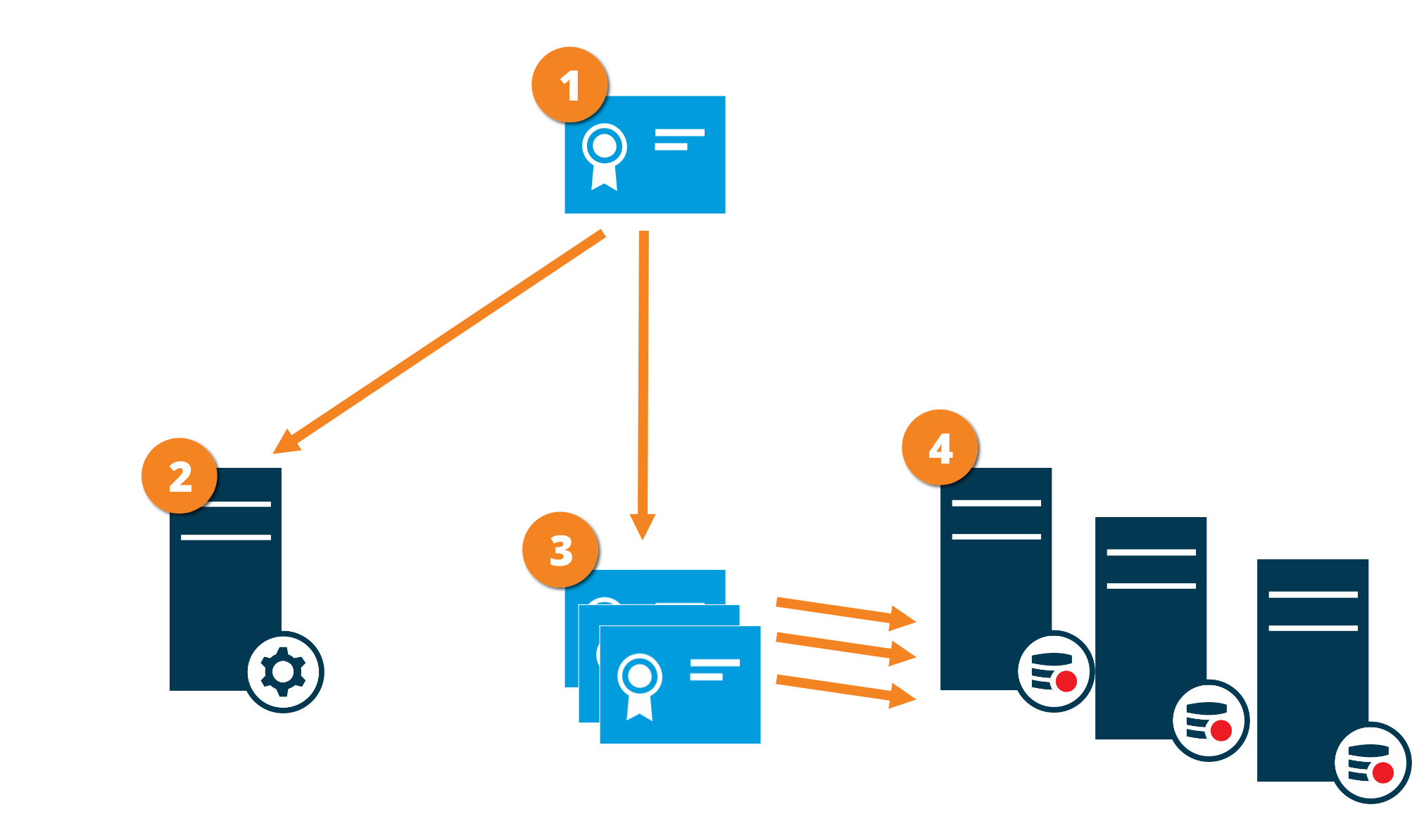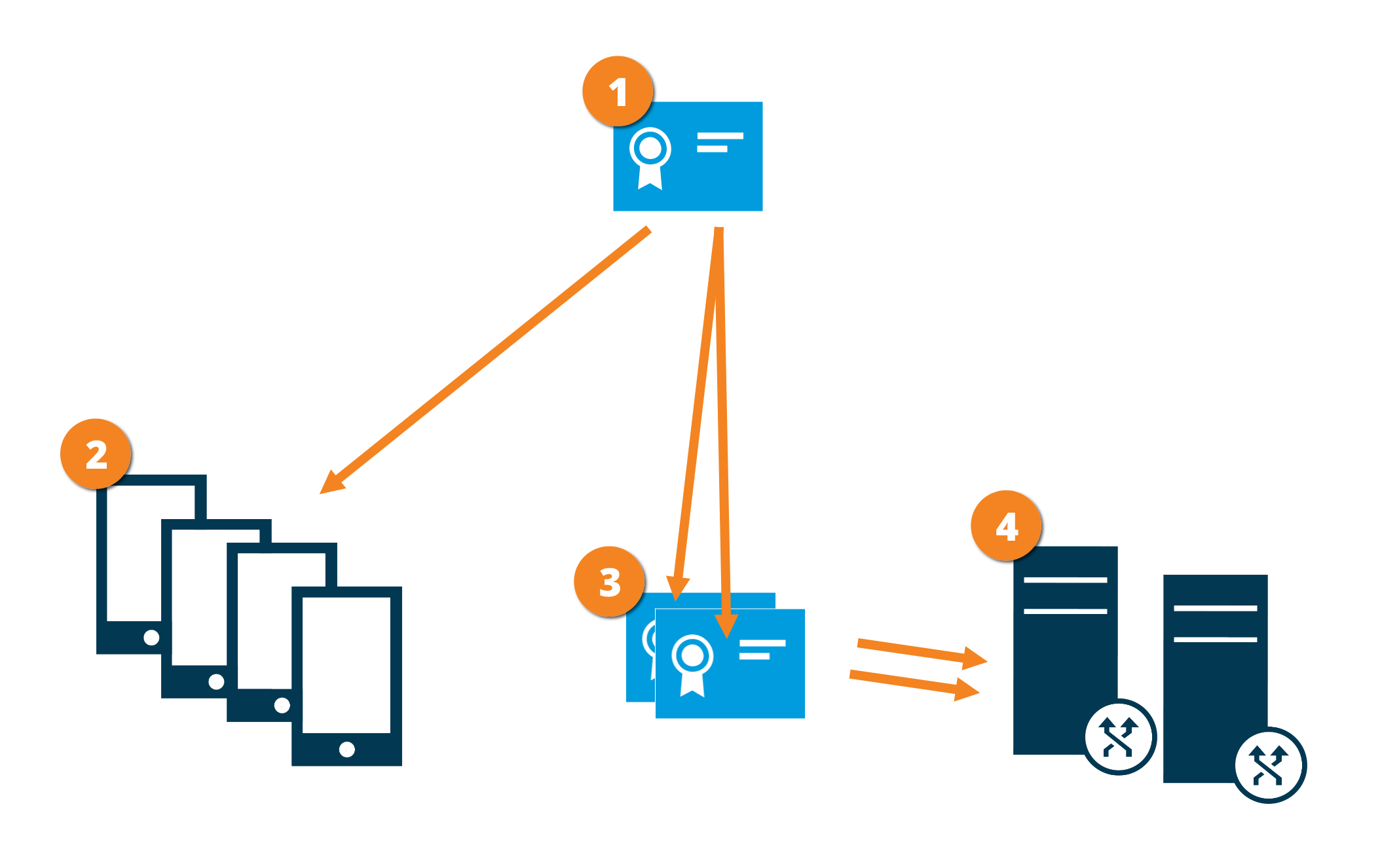Secure communication (explained)
Hypertext Transfer Protocol Secure (HTTPS) ist eine Erweiterung des Hypertext Transfer Protocol (HTTP) für die sichere Kommunikation über ein Computernetzwerk. In HTTPS wird das Kommunikationsprotokoll mithilfe der Transport Layer Security (TLS) oder ihrem Vorläufer, Secure Sockets Layer (SSL), verschlüsselt.
In XProtect VMS wird eine sichere Kommunikation durch die Verwendung von TLS/SSL mit asymmetrischer Verschlüsselung (RSA) erreicht.
TLS/SSL verwendet ein Schlüsselpaar - einen privaten und einen öffentlichen - zur Authentifizierung, Sicherung und Verwaltung sicherer Verbindungen.
Eine Zertifizierungsstelle (CA) ist jeder, der Stammzertifikate ausstellen kann. Dabei kann es sich um einen Internetdienst handeln, der Stammzertifikate ausstellt, oder um jeden, der ein Zertifikat manuell erstellt und verteilt. Eine CA kann Zertifikate für Webdienste ausstellen, d. h. für jede Software, die die Kommunikation über https nutzt. Dieses Zertifikat enthält zwei Schlüssel, einen privaten und einen öffentlichen. Der öffentliche Schlüssel wird auf den Clients eines Web-Dienstes (Dienst-Clients) installiert, indem ein öffentliches Zertifikat installiert wird. Der private Schlüssel dient dazu, Serverzertifikate zu signieren, die auf dem Server installiert werden müssen. Jedes Mal, wenn ein Dienst-Client den Web Service anruft, sendet der Web Service dem Client das Server-Zertifikat, einschließlich des öffentlichen Schlüssels. Der Dienst-Client kann das Serverzertifikat mithilfe des bereits installierten, öffentlichen CA-Zertifikates überprüfen. Der Client und der Server können nun mit Hilfe der öffentlichen und privaten Serverzertifikate einen geheimen Schlüssel austauschen und so eine sichere TLS/SSL-Verbindung aufbauen.
Bei manuell verteilten Zertifikaten müssen die Zertifikate installiert werden, bevor der Client eine solche Überprüfung vornehmen kann.
Siehe Transportschichtsicherheit für weitere Informationen über TLS.
Zertifikate haben ein Verfalldatum. XProtect VMS gibt Ihnen keine Wahrnung, wenn das Zertifikat in Kürze abläuft. Wenn ein Zertifikat abläuft:
- Die Clients vertrauen dann nicht mehr dem Aufzeichnungsserver mit dem abgelaufenen Zertifikat und können daher auch nicht mehr mit ihm kommunizieren.
- Die Aufzeichnungsserver vertrauen dann nicht mehr dem Managementserver mit dem abgelaufenen Zertifikat und können daher auch nicht mehr mit ihm kommunizieren.
- Die mobilen Geräte vertrauen dann nicht mehr dem Mobile Server mit dem abgelaufenen Zertifikat und können daher auch nicht mehr mit ihm kommunizieren
Um die Zertifikate zu erneuern, folgen Sie den Schritten in dieser Anleitung, wie Sie es bereits getan haben, als Sie Zertifikate erstellt haben.
Management server encryption (explained)
You can encrypt the two-way connection between the management server and the recording server. When you enable encryption on the management server, it applies to connections from all the recording servers that connect to the management server. If you enable encryption on the management server, you must also enable encryption on all of the recording servers. Before you enable encryption, you must install security certificates on the management server and all recording servers.
Certificate distribution for management servers
The graphic illustrates the basic concept of how certificates are signed, trusted, and distributed in XProtect VMS to secure the communication to the management server.

 A CA certificate acts as a trusted third party, trusted by both the subject/owner (management server) and by the party that verifies the certificate (recording servers)
A CA certificate acts as a trusted third party, trusted by both the subject/owner (management server) and by the party that verifies the certificate (recording servers)
 The CA certificate must be trusted on all recording servers. In this way, the recording servers can verify the validity of the certificates issued by the CA
The CA certificate must be trusted on all recording servers. In this way, the recording servers can verify the validity of the certificates issued by the CA
 The CA certificate is used to establish a secure connection between the management server and the recording servers
The CA certificate is used to establish a secure connection between the management server and the recording servers
 The CA certificate must be installed on the computer on which the management server is running
The CA certificate must be installed on the computer on which the management server is running
Requirements for the private management server certificate:
- Issued to the management server so that the management server's host name is included in the certificate, either as subject (owner) or in the list of DNS names that the certificate is issued to
- Trusted on the management server itself, by trusting the CA certificate that was used to issue the management server certificate
- Trusted on all recording servers connected to the management server by trusting the CA certificate that was used to issue the management server certificate
Recording server data encryption (explained)
Encryption to clients and servers that retrieve data from the recording server
When you enable encryption on a recording server, communication to all clients, servers, and integrations that retrieve data streams from the recording server are encrypted. In this document referred to as 'clients':
- XProtect Smart Client
- Management Client
- Management Server (for System Monitor and for images and AVI video clips in email notifications)
- XProtect Mobile Server
- XProtect Event Server
- XProtect LPR
- Milestone Open Network Bridge
- XProtect DLNA Server
- Sites that retrieve data streams from the recording server through Milestone Interconnect
- Some third-party MIP SDK integrations
Certificate distribution
The graphic illustrates the basic concept of how certificates are signed, trusted, and distributed in XProtect VMS to secure the communication to the recording server.

 A CA certificate acts as a trusted third-party, trusted by both the Subject/owner (recording server) and by the party that verify the certificate (clients)
A CA certificate acts as a trusted third-party, trusted by both the Subject/owner (recording server) and by the party that verify the certificate (clients)
 The public CA certificate must be trusted on all client computers. In this way the clients can verify the validity of the certificates issued by the CA
The public CA certificate must be trusted on all client computers. In this way the clients can verify the validity of the certificates issued by the CA
 The CA certificate is used to issue private server authentication certificates to the recording servers
The CA certificate is used to issue private server authentication certificates to the recording servers
 The created private recording server certificates must be imported to the Windows Certificate Store on all recording servers
The created private recording server certificates must be imported to the Windows Certificate Store on all recording servers
Requirements for the private recording server certificate:
- Issued to the recording server so that the recording server's host name is included in the certificate, either as subject (owner) or in the list of DNS names that the certificate is issued to
- Trusted on all computers running services that retrieve data streams from the recording servers, by trusting the CA certificate that was used to issue the recording server certificate
- The service account that runs the recording server must have access to the private key of the certificate on the recording server.
If you enable encryption on the recording servers and your system applies failover recording servers, Milestone recommends that you also prepare the failover recording servers for encryption.
Encryption from the management server
You can encrypt the two-way connection between the management server and the recording server. When you enable encryption on the management server, it applies to connections from all the recording servers that connect to the management server. Therefore, you need to enable encryption on all the recording servers. Before you enable encryption, you must install security certificates on the management server and all recording servers.
Certificate distribution
The graphic illustrates the basic concept of how certificates are signed, trusted, and distributed in XProtect VMS to secure the communication from the management server.

 A CA certificate acts as a trusted third party, trusted by both the Subject/owner (recording server) and by the party that verify the certificate (management server)
A CA certificate acts as a trusted third party, trusted by both the Subject/owner (recording server) and by the party that verify the certificate (management server)
 The public CA certificate must be trusted on the management server. In this way the management server can verify the validity of the certificates issued by the CA
The public CA certificate must be trusted on the management server. In this way the management server can verify the validity of the certificates issued by the CA
 The CA certificate is used to issue private server authentication certificates to the recording servers
The CA certificate is used to issue private server authentication certificates to the recording servers
 The created private recording server certificates must be imported to the Windows Certificate Store on the management server
The created private recording server certificates must be imported to the Windows Certificate Store on the management server
Requirements for the private recording server certificate:
- Issued to the recording server so that the recording server's host name is included in the certificate, either as subject (owner) or in the list of DNS names that the certificate is issued to
- Trusted on the management server, by trusting the CA certificate that was used to issue the recording server certificate
- The service account that runs the recording server must have access to the private key of the certificate on the recording server.
Mobile server data encryption (explained)
In XProtect VMS wird die Verschlüsselung für jeden mobilen Server aktiviert oder deaktiviert. Wenn Sie die Verschlüsselung auf einem mobilen Server aktivieren, so können Sie sich aussuchen, ob Sie die verschlüsselte Kommunikation mit allen Clients, Diensten und Integrationen verwenden wollen, die Datenstreams abrufen.
Verteilung von Zertifikaten für mobile Server
Die Grafik illustriert das zugrundeliegende Konzept dafür, wie Zertifikate signiert werden, wie ihnen vertraut wird, und wie diese in XProtect VMS verteilt werden, um die Kommunikation mit dem mobilen Server zu sichern.

 Eine CA fungiert als vertrauenswürdiger Dritter, dem sowohl das Thema/der Eigentümer (mobiler Server) vertraut, als auch die Partei, die das Zertifikat überprüft (alle Clients).
Eine CA fungiert als vertrauenswürdiger Dritter, dem sowohl das Thema/der Eigentümer (mobiler Server) vertraut, als auch die Partei, die das Zertifikat überprüft (alle Clients).
 Dem öffentlichen CA-Zertifikat muss auf allen Clientcomputern vertraut werden. Auf diese Weise können die Clients die Gültigkeit der von der CA ausgegebenen Zertifikate überprüfen
Dem öffentlichen CA-Zertifikat muss auf allen Clientcomputern vertraut werden. Auf diese Weise können die Clients die Gültigkeit der von der CA ausgegebenen Zertifikate überprüfen
 Das CA-Zertifikat dient zur Herstellung einer sicheren Verbindung zwischen dem Mobile Server und den Clients und Diensten
Das CA-Zertifikat dient zur Herstellung einer sicheren Verbindung zwischen dem Mobile Server und den Clients und Diensten
 Das CA-Zertifikat muss auf dem Computer installiert werden, auf dem der mobile Server läuft
Das CA-Zertifikat muss auf dem Computer installiert werden, auf dem der mobile Server läuft
Anforderungen für das CA-Zertifikat:
- Der Hostname des mobilen Servers muss im Zertifikates enthalten sein, entweder als Thema (Besitzer) oder in der Liste der DNS-Namen, an die das Zertifikat ausgegeben wird
- Dem Zertifikat muss von allen Computern vertraut werden, die Dienste ausführen, die Datenstreams vom mobilen Server abrufen
- Das Dienstkonto, auf dem der Aufzeichnungsserver läuft, muss Zugriff zum privaten Schlüssel des CA-Zertifikates haben.

